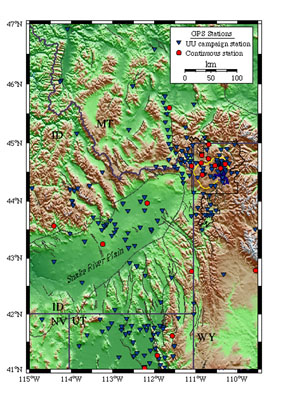geotimesheader
News
Notes
Field
Notes
Animal Engineering
The notion that the whole is greater than the
sum of its parts holds true for the giant pink Queen conch — or rather
its calcium carbonate domicile. The shell of Strombus gigas is made
of aragonite, a polymorph of calcium carbonate, and interlayered protein
secreted by the animal. This natural composite material is one hundred
to one thousand times stronger than solitary calcium carbonate thanks to
ingenious engineering on the part of the conch. Stress is dissipated across
layers through a series of microcracks rather than through one large fracture.
Arthur Heuer and colleagues at Case Western Reserve University examined
the structural basis for the strength of the conch shell and found that
the key lies in the complex crossed lamellar structure of the aragonite.
Their findings reveal details about the conch’s feat of engineering that
may have applications for building stronger ceramics and other strong,
lightweight materials.
L.W.
More tsunamis?
The East Coast tsunami lookout continued this
summer with a report in the July 14 Science. Peter Flemings of Pennsylvania
State University took sediment cores from the continental slope off the
coast of New Jersey that have revealed subsurface zones of undercompacted
sediment with high fluid pressure. Flemings believes these pressures may
lead to sediment failure — and possibly a tsunami. Earlier this summer,
Neal Driscoll of the Woods Hole Oceanographic Institution and his colleagues
drew attention to submarine features off the East Coast as potential tsunami
threats, but they concluded that high-pressure gas is the most likely explanation.
Flemings sampled sediment in 1997 at Ocean Drilling Program site 1073 from
the JOIDES Resolution. Like Driscoll, who discovered large
zones of disturbed sediment off the coast of Virginia and the Carolinas
(Geotimes, July 2000), Flemings claims that the sediments could
violently release their pressurized contents if disturbed. Such a sediment
collapse could cause a tsunami. However, the probability of a tsunami striking
the New Jersey shore has not been determined and the scientists plan to
continue their research.
L.W.
| Yellowstone
hot spot
Combining data from about 200 Global Positioning
System (GPS) receivers and 300 seismometers, a team of geophysicists will
model the Yellowstone hot spot, which fuels geothermal activity beneath
and around Yellowstone National Park and the Yellowstone caldera.
The team hopes to determine whether the hot spot
is powered from the mantle or extends to the core-mantle boundary, says
co-leader Eugene Humphreys of the University of Oregon. Most of the seismic
array will sit at the park’s northeast corner and measure the arrival times
of earthquake waves from the Tonga and Fiji islands.
The hot spot and its tectonics extend beyond Yellowstone
for at least a 200-kilometer radius, says lead researcher Robert Smith
of the University of Utah. The six seismic arrays contain about 300 seismometers
and cover Montana, Idaho, Utah, northern Nevada and Wyoming. The researchers
will collect data this winter.
K.B.
Figure at right from www.nimes.utah.edu/~ggcmpsem/UUSATRG/CD-Yel/GPS/FIGS/topo.html. |

Distribution of GPS campaign
stations in the
Yellowston-Snake River Plain
region. |
Diversity
mandate
July 13, WASHINGTON
Science, engineering and technology jobs continue
to increase, greatly outpacing the number of Americans qualified to fill
them, according to the Commission on the Advancement of Women and Minorities
in Science, Engineering and Technology Development (CAWMSET). Also called
the Morella Commission after its advocate, Rep. Connie Morella (R-Md.),
the congressionally mandated commission released its report today, calling
for immediate, focused action to increase diversity in the science, engineering
and technology workforce. By 2020, the commission reports, almost one-third
of the American workforce will be racial and ethnic minorities, and almost
one-half women. “Growing the American talent pool will require a major
shift in how we now educate, train and recruit citizens in the fields of
science, engineering and technology,” said Elaine Mendoza, chair of the
commission.
B.M.
A story on the CAWMSET report
will appear in the September Geotimes. For more on the commission,
visit www.nsf.gov/od/cawmset.

